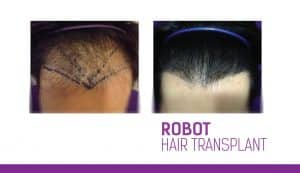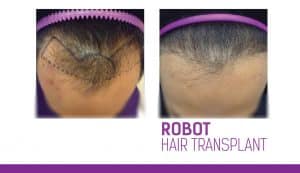What is Robot Hair Transplant ?
Robotic Hair Transplant’. The sophisticated process uses state-of-the-art technology such as computer assistance to harvest hair follicles and a semi robotic arm to remove and replace the follicular units more accurately. However, a human touch is also required because each person’s hairline is unique, so the doctor’s skill and artistic execution are essential to achieve a more natural look. The hi-tech procedure makes the process more accurate and also speeds it up. The other advantages are that it is the least invasive of its kind, meaning there are no scalpel incisions, sutures or linear scars, making it a surgery with less pain and the fastest recovery time.
HOW’S A HAIR TRANSPLANT PERFORMED?
Before the Robotic hair transplant recently got an FDA approval, a traditional hair
transplant was done. In a hair transplant, follicle units or groups of one or four hairs from one part of the body are removed under local anesthesia with tiny punches of between 0.6mm and 1.25mm in diameter made or by take out the whole strip from the back and stitches them back up.These follicles are then reinserted back into the scalp in the thinning or bald area using a micro blade. This procedure can dense back thinning areas with as many as 40 to 60 follicular unit grafts per square centimeter.
HOW’S THE NEW TECHNOLOGY, ROBOTIC HAIR TRANSPLANT, ANY BETTER?
When performing a follicle unit extraction, which is the type of transplant I explained
above, removing units of hair has always proved to be the toughest part of this method. It could take several hours or even multiple sessions to punch out the tiny follicle units needed for a natural looking hair transplant. The machine can help speed up the process in a more accurate manner. Another problem is that it’s very difficult to correctly place the follicular unit graft in the recipient area to give a natural appearance. The robot changes that. It has an arm that is able to insert the follicular unit onto a scalp more accurately using better quality of hair. This gives us doctors a better quality of hair to work with, result in a more natural growth of implant unit.
However how the transplant will ultimately look still depends on your doctor’s expertise. The other advantages of this new technology are that it is the least invasive of its kind, meaning there are no scalpel incisions, sutures or linear scars, making it a surgery with less pain and the fastest recovery time. You can go back to work the very next day. Also, since no scars are involved, you do not need to worry about the tightening and pain on the scar area.
The results of a Robot hair transplant
How does it work?

How long does it take?
Once you have undergone FUE, the results are permanent. While the initial transplanted hair will shed a few weeks after treatment, it will grow back strong and healthy.
How long do results last?
Once you have undergone Robot Hair Transplant, the results are permanent. While the initial transplanted hair will shed a few weeks after treatment, it will grow back strong and healthy.
How long does it take to recover?
Unlike strip surgery, Robot hair transplantation does not require large areas of the scalp to be harvested. There is also no linear incision on the back of the head, nor does it leave a linear scar.
How long do results last?
Once you have undergone Robot Hair Transplant, the results are permanent. While the initial transplanted hair will shed a few days after treatment, it will grow back strong and healthy.
How much does a Procedure Cost?
The cost of the procedure depends on the number of grafts and the complexity of the area to be transplanted. All costs quoted include check-ups and post-operative medications. Repair cases are complex and a speciality at the clinic. Due to the challenging nature of corrective surgery we have to examine patients in detail before providing a cost estimate.
What is Donor Management?
The donor hair available to patients during a lifetime is limited and we have to make the correct choice to ensure we select the best strategy to make sure the donor hair is used wisely over a patient’s lifespan. This is crucial to ensure patients gain the best result possible and be educated regarding the potential for future hair loss.
Do you offer Finance Facilities?
Yes we can provide 10 month interest free credit agreements via our finance partner. Please ask for further details at your consultation.
Am I a suitable candidate?
We always advise arranging a personal consultation as there are many variables to investigate including your age, family history of hair loss, and type of hair loss. These factors determine your overall suitability for treatment.
Do I have to cut my hair short?
In certain cases we can transplant without cutting the hair short depending on the number of grafts required. However, in the majority of cases we do cut the hair short to gain the maximum quality grafts possible.
How many procedures do I need?
The number of procedures required depends on your goals, your present level of hair loss and how this changes in the future. The majority of patients require 2 procedures in their lifetime.
Will the results be natural?
We have a strict protocol that ensures we only have doctors completing the placement to ensure the naturalness of the final result. The Robot hair transplant procedure requires excellent surgical skills and natural artistic flair and we encourage you to view our gallery to see how we achieve the natural results which are the hallmark of a great hair transplant.
How long before I see the results
The transplanted hair will begin to shed at 2 weeks post procedure and will then take a further 2-4 months to start re-growing. At around the 6 month stage we expect the regrowth to be at the half way stage and the final result is achieved at 12-14 months. The progress can vary and we recommend you attend the 6 month check up to review progress.
Can I get a full head of hair again?
A hair transplant cannot replace the natural density of a full head of hair but using surgical planning and artistic placement we can maximize the appearance of natural density and volume.
Are there any risks to my health in having a PROCEDURE?
The Robot Hair Transplant procedure is a very safe and minimally invasive procedure under local anesthetic. There are very few potential health risks and, as with any surgical procedure, we take full medical precautions including ECG tests at the clinic for patients aged over 45.
What is Shock loss?
Shock loss is the loss of pre-existing or transplanted hair due to the trauma of a surgical procedure. The incidences of shock loss are rare and any hair loss caused is temporary and normal growth returns after a period of 1-3 months. Shock loss is a potential side effect of transplantation and is minimized by the expertise of our vastly experienced medical team.
How does it work?
During the process, individual follicles – typically between 1 and 4 hairs – are removed under local anaesthesia. The extraction procedure utilises a micro surgical extraction instrument, between 0.6mm and 1.0mm in diameter, to remove the follicles.
The surgeon, using specialist micro surgical needles, then punctures the scalp area that is to receive the grafts. Our surgeons are experts at blending the hair in, inserting the grafts at an angle and density that matches the original hair, so it will resemble a natural and realistic hair pattern.
How long does it take?
A Robot hair transplant can be undergone in either one long session, or several smaller sessions. It tends to be more time consuming than strip surgery, but does not leave the obvious and typical scars that strip surgery does.
The length of time for a procedure can vary, but it usually depends on how many grafts are needed. A smaller procedure, where only around 500-1,000 grafts are needed, can be completed in 4 hours. However, a larger procedure of around 2,500 to 3,000 grafts will require a session that stretches over 6-8 hrs.
How long does it take to recover?
Unlike strip surgery, Robot hair transplantation does not require large areas of the scalp to be harvested. There is also no linear incision on the back of the head, nor does it leave a linear scar.
As individual follicles are removed, it only leaves small, puncture scars, which are practically invisible to the naked eye. There is hardly any post-surgical pain and discomfort – with the average recovery time being less than 2-3 days.
How long do results last?
Once you have undergone Robot hair transplant, the results are permanent. While the initial transplanted hair will shed a few weeks after treatment, it will grow back strong and healthy.












